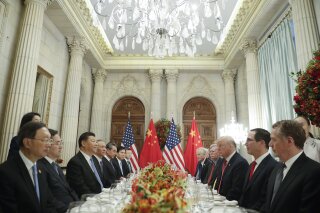AP FACT CHECK: Trump claims wrong drug concession from China

President Donald Trump, right, China’s President Xi Jinping, left, and members of their delegations during their bilateral meeting at the G20 Summit, Saturday, Dec. 1, 2018 in Buenos Aires, Argentina. (AP Photo/Pablo Martinez Monsivais)
SHANGHAI (AP) — U.S. President Donald Trump is claiming victory in getting China to designate fentanyl a controlled substance, but China took that step against the deadly opioid years ago.
What’s actually on the table is a far more sweeping shift in the way China regulates synthetic opioids. The question is how China will follow through on its words.
China’s stated intention is to expand controls on all varieties of drugs that mimic fentanyl, a step advocated by U.S. officials eager to end the game of regulatory whack-a-mole with chemists who can manufacture novel opioids faster than they can be banned.
TRUMP, about his meeting at the G-20 summit in Argentina with Chinese President Xi Jinping: “What he will be doing to fentanyl could be a game changer for the United States — and what fentanyl is doing to our country in terms of killing people. Because he’s agreed to put it at the highest level of crime in his country.” — aboard Air Force One on Saturday.
WHITE HOUSE: “Very importantly, President Xi, in a wonderful humanitarian gesture, has agreed to designate Fentanyl as a Controlled Substance, meaning that people selling Fentanyl to the United States will be subject to China’s maximum penalty under the law.” — statement Saturday.
THE FACTS: That’s a misreading of what China agreed to do, at least as far as Chinese authorities are concerned.
Fentanyl has been a controlled substance in China for years, according to Chinese regulators . All told, China has already put 25 variants of fentanyl, plus two precursors — chemicals used to make the drug — on its list of controlled substances, Chinese foreign ministry spokesman Geng Shuang said last week.
Now, “China has decided to list all the fentanyl-like substances as controlled substances and start working to adjust related regulations,” says China’s foreign ministry .
Doing so could help block China’s opioid merchants from skirting the law by inventing new chemical variants of fentanyl faster than regulators can declare them illegal.
The standard approach of regulating drugs one by one has failed to control the proliferation of new and deadly synthetic opioids in the United States.
In February, the U.S. said that for at least the next two years, all new chemical versions of fentanyl that weren’t already regulated would be classified as illegal controlled substances. U.S. officials had been urging China to do something similar.
But China hasn’t always followed through on its promises. “Similar suggestions have failed to gain approval from Chinese regulators in the past,” the U.S.-China Economic and Security Review Commission said in a report last week that criticized China for “slow and ineffective” regulation of fentanyl.
In 2016, U.S. negotiators thought they had secured an agreement with Beijing that China would target U.S.-bound exports of substances that were illegal in the United States, even if they weren’t illegal in China, but Beijing never implemented the policy, according to the commission, a group formed by the U.S. Congress to monitor economic relations with China.
China’s new approach could indeed be game changing, as Trump said. But so far there’s no timeline for implementation of the policy.
On Monday, Geng, the foreign ministry spokesman, said, “I think this is just an announcement from the Chinese side. The specific work still needs further development.”
___
Associated Press researchers Si Chen in Shanghai and Liu Zheng in Beijing and AP Medical Writer Lauran Neergaard in Washington contributed to this report.
___
Find AP Fact Checks at http://apne.ws/2kbx8bd
Follow @APFactCheck on Twitter: https://twitter.com/APFactCheck
